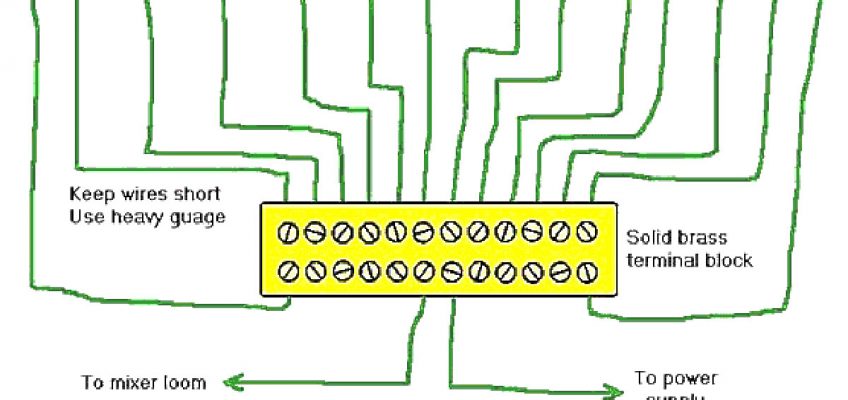In this technology article, John Matheson explores the root causes of hums and buzzes in sound systems and shares tips for eliminating them.
I’m going to try not to offend anyone – except perhaps equipment manufacturers!
In my former life as head of a performing arts centre sound department, one of the things I used to enjoy most was being called in, usually at the last minute, to sort out a noisy sound system. Not!
You know, when those bastard lighting dimmer circuits are causing deafening levels of electric buzz in the foldback loudspeakers, in the guitar channel and in the reverb unit.
It will astound you to know that all problems with hums and buzzes are caused by audio equipment manufacturers not understanding Ohm’s Law. Yes, that simple equation V=IxR (voltage equals current times resistance). How, why, you ask?
What Ohm’s Law tells us is that current cannot flow without a voltage drop. (See Figure 1.) If a conductor, screen or wire that is a signal earth reference is also carrying current, then it is no longer a signal reference, it is a noise voltage source! The trick is not to create circuits in which the noise current can flow. We all know these circuits by the dreaded name earth loops.
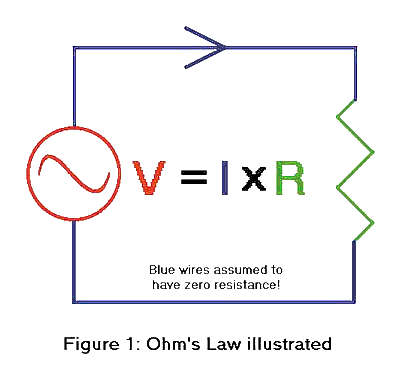
Building from the Noise floor Up!
Without any input connected, a piece of professional audio equipment should have nothing other than semiconductor sshh… noise in its output. If you don’t know what I mean by sshh… noise, then have a listen to an FM tuner off station with the mute off: that’s sshh… noise. It’s also a bit like listening from a distance to a big surf swell at the sea. Remember this sound, it’s normal in very small doses.
The mixing console is the heart of a big sound system where everything comes together. It is important that the mixer has a solid earth buss, and they often don’t.
A solid earth wire from each connector’s pin one or sleeve will shunt noisy earth currents to ground via the mixer’s power supply earth, bypassing the noisy currents from circuits inside.
Assuming you have bought a solidly earthed mixer (unlikely) or you have already modified your mixer (more likely), have a listen to the solo or pre-fade* buss output, on a pair of headphones with the monitor volume at max. Make sure all input and output knobs or faders are at minimum and NOTHING other than power is connected to the mixer. (*If you are unlucky enough to have an old Kelsey mixer, this is called the “zoom”. The Kelsey Sound Prism is the only mixer I have ever seen with a connector on the back labelled “Zoom Stack Buss Input”!!)
Have a listen to each output, both main and auxiliary; they should all be dead quiet except for a little bit of semiconductor sshh… noise. If you can’t pre-fade the outputs, then monitor them post-fade (remember to put the fader up!) If you can’t hear the noise floor, which should sound like I described above, then sadly it doesn’t mean you’ve got a super quiet desk. It means your mixer’s headphone output has insufficient gain; try to find some more sensitive headphones, or get your electronics guru to modify the headphone output driver circuit. It is important to be able to hear the noise floor.
There should be no hum, no buzz, no frying and no sizzle- just sshh… noise. If there is a tiny little bit of hum, it may be because the mixer’s power supply is a bit thin on filtering, or that the mixer manufacturer doesn’t know Ohm’s Law and has let power supply current run down a wire used for a signal ground somewhere. If there is a bad hum or buzz, it’s time to get your electronics guru in to check the mixer earthing tips below, or time to sell your prized mixer to some unfortunate sucker!
Anyway, you have now found the mixer’s noise floor. (It’s caused by weeny little electrons whizzing around in circles and crashing into dumb atoms that get in the way, whilst they wait to do your signal’s bidding.)
The Golden Rule
Follow this golden rule and you will eliminate the most difficult hum, interference and buzz problems and have a perfectly clean, low noise system every time! I promise!
Connect NOTHING to the mixer that degrades its noise floor!
If connecting something degrades the mixer’s noise floor, consider it a fault and fix it. Every time you plug something in to the mixer, check the noise floor to make sure it is still OK. I expect that you will find that one or all of the auxiliary busses will be the worst affected by an earth fault and one makes a good “litmus test”.
Remember Year 8 science class? A litmus test was a little it of paper that changed colour from blue to red when place in acidic solutions, or from red to blue in alkaline solutions. It is a pass/fail test. Either a solution is acidic or it is not. In our case, either the noise floor has changed (fail), or it has not (pass).
An earth fault on a given channel often does not cause noise in its own channel, which is why the noise floor litmus test is so important. What is more, two earth faults compounded may cause less noise than either fault on its own; use the litmus test after every single connection is made!
This is where I start when fault finding someone else’s noisy installation – unplug everything from the desk (after labelling each lead if the sound technician hasn’t already) and find its noise floor. Then I plug things back in one at a time, fixing faults as I find them. It’s easier and quicker to get it right in the first place. Even so, it’s never taken me more than an hour or two to have a large and complex sound reinforcement system totally clean.
Something I haven’t tried, but ought to work well and be really convenient, is to plug the mixer’s monitor output into a spectrum analyser with its input gain cranked up to show the noise floor. Watch the display as you plug things in – you should immediately see the result of earth faults.
Balanced, Unbalanced and Floating (Quasi-balanced) Circuits
An electric signal needs a complete circuit for current to flow, therefore at least two wires or connections are required between a signal source and its destination. We also need to screen the signal from induced noise pick-up along the way. There are two types of connection – those that use one of the two signal wires as a screen are called unbalanced, and those that use a separate screen may be either balanced or floating. (See fig 2).
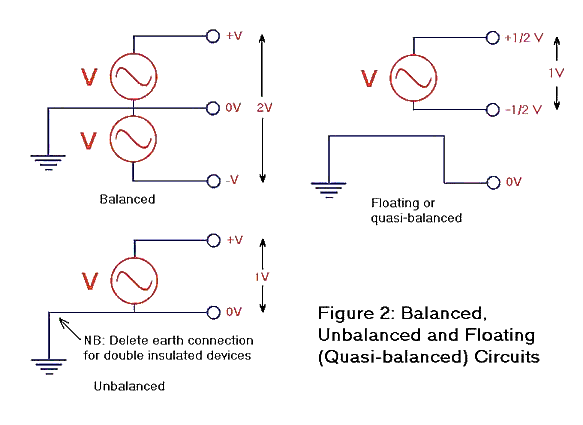
In a balanced circuit, the two signal wires seesaw above and below earth, always equal and opposite in potential about earth. A floating output is not referenced to earth. Neither floating or balanced circuits require the screen wire to be connected at both ends, nor should it be! (Microphones, DI’s and double insulated equipment excepted.) In most circumstances the screen should connect at the source end, not the input end. If you are lucky, your mixer will have an earth lift switch on every line input, to make life easy.
Since an output may be balanced, unbalanced or floating, and an input may be balanced or unbalanced, there are six possible combinations of source to destination wiring! No one method of wiring will work for all circumstances, but don’t worry, I’ve got solutions for all of them.
Mixing Consoles
Assuming your mixer is not double insulated, which some small ones are, make sure that your have a solid, reliable earth connection from inside the mixer, through its power supply, power lead and mains power outlet. Watch out for loose connections. For chassis connections always use lugs with a star washer under to ensure a good contact through paint, coatings or corrosion, and use a spanner, not pliers, to do up nuts really tight.
All mixing consoles, bar the most expensive, run unbalanced mix busses inside. This makes them very susceptible to induced noise from earth currents running through the mixer. If your mixer has dubious earthing (ie if you can’t see an earthing loom like the one described in Figure 3) even if it’s double insulated, you can try installing an earth loom as illustrated. Note: this will NOT eliminate induced noise problems, but it will reduce them substantially.
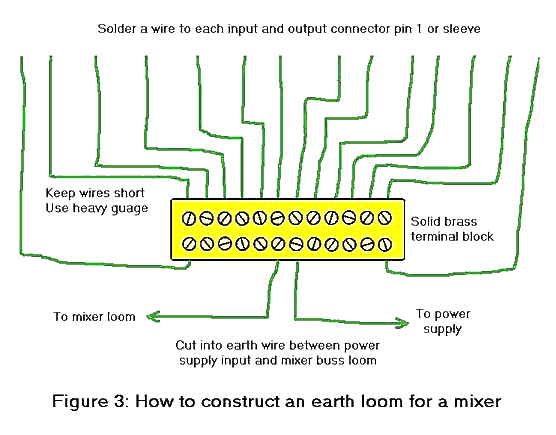
What happens is that the new earth shunt is in parallel with the existing earth buss in the mixer, greatly reducing the resistance through which the noise current flows. However, because the noise voltage V=IxR, we would need R to be infinitesimally small for V to approach zero. Since we can’t get high temperature superconductor wire from Dick Smith’s (yet) we cannot eliminate the shunt resistance or consequently the noise voltage.
Unfortunately, depending on the mixer’s circuit board layouts and internal loom wiring, it is possible, though unlikely, that this new earth loom will degrade the noise floor of the desk, in which case you are stuck between a rock and a hard place. Look for that sucker to buy your desk!
Avoid putting a metal cased mixer directly onto a metal-framed stand, which may somehow connect to a ground. Keep your mixer insulated, except for its own power earth in the case of a non double insulated mixer.
Microphones
The body of a microphone is usually connected to the earth from the mixer via the screen. It will introduce noise if it contacts another metal, earthed object. Watch out for microphones that touch music stands or structural steel. Use plastic or insulated clips. Don’t clip a lapel microphone to anything metal, like music stands, without insulating it.
After you have checked the mixer noise floor is still OK, then check the microphone noise floor. If there’s any buzz on the microphone channel with its gain wound up, make sure the cable has a braided screen with 95% or more coverage, and check the screen connection at both ends of the cable. If it runs down a multi-core, you will also have to check the integrity of the `core.
If your cable buzzes badly without a microphone plugged in, throw it out and buy some decent star quad cable like Canare, Hartland or Beldon. The star quad construction gives an additional 20dB of immunity to noise pick-up on the cable.
If the cable on its own doesn’t buzz, but the microphone does when plugged in, you’ve either got a lousy microphone, or you’re in an extremely high strength electromagnetic field- get out quick! Note, some older design dynamic microphones and ribbons may be somewhat susceptible to induced hum. Keep them away from sources of interference.
Direct Injects (DIs)
It can be very tricky to get noise free connections to a crappy designed musical instrument amplifier. Firstly, the instrument, guitar, keyboard, or pick-up is unbalanced, so it is referenced to what is inevitably a dirty earth. Secondly, the screen needs to be continuous from the instrument amplifier to the instrument, through the DI, and can not be broken without potentially introducing noise into the musical amplifier.
It is best to keep the mixer earth separated from the instrument earth. Do not put a “suicide” plug (which breaks the mains power earth) on the musical amplifier. Musicians have been killed this way. (You may think you are carrying out a service to humanity, but the authorities are likely to take a dim view of this practice!)
If you have passive, transformer type DI’s, use the earth lift switch or an earth isolation adaptor to separate the instrument and mixer earths. Unfortunately, passive DI’s may alter the sound of an instrument plugged through them, because of their relatively low bridging impedance.
If you are using an active DI with batteries, use the earth lift as above. If the DI only runs on phantom power or its batteries are flat, the only option is to run mains power for the musical amplifier from the mixer’s mains power source, or at least the same switchboard. Then, as long as no other equipment earth faults are introduced, there will be no additional noise voltage on the musical amplifier’s earth other than what it generates internally, relative to the mixer’s earth.
If you want the best of all worlds, i.e. a extremely high impedance, earth lift-able, phantom powered, high end audiophile quality DI, check out The Leon Audio Company.
This fancy DI came out of one of those long nights when the scotch was flowing and your author and Ian Du Rieu of Leon Audio dreamed up the perfect specification for a DI!
Once you have plugged in the DI and satisfied yourself with the litmus test, before you plug in any instrument leads check to see if the DI channel is clean. If it isn’t, chuck it out and get a decent one. It must have jack connectors, which are insolated from chassis, so that the earth from the mixer screens the guts of the DI, even when the lift switch is operated.
Then plug in the instrument and amplifier and attempt to solve the noise problems at that end. (See Figure 4.) Start by throwing out the musician’s crappy guitar leads and giving him some decent ones. Don’t expect to get them back, just think that maybe one day you’ll be knighted for services to the music industry.
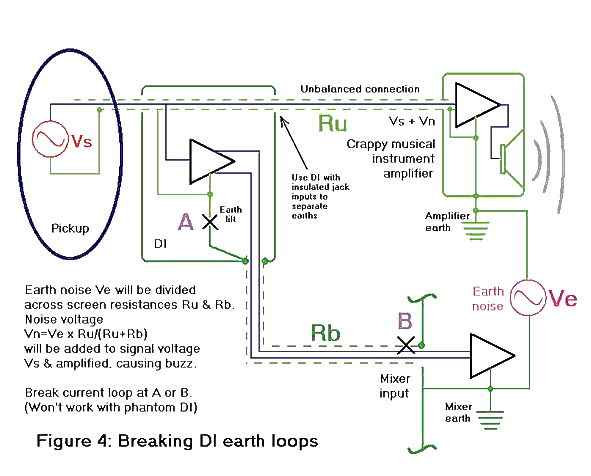
Guitar and other instrument pick-ups are generally very susceptible to induced noise, especially ones with built-in unscreened tone controls. Your only solution may be to insert a noise gate or downward expander to quiet things down. I once had to line an orchestra pit around a bass guitarist with earthed aluminum decal foil (stiff tin foil) to shut up his pick-up. If the musicians are in an orchestra pit with dimmed lighting, ask the electrics crew to put a “Variac” on the sconce lights instead of using an electronically dimmed lighting circuit.
Mains Powered Equipment
The trouble with mains powered equipment is, unless it is double insulated, it will most likely have its signal reference tied to its power earth, which is going to be a different potential to the mixer’s power earth. The reason for this difference in earth potentials may be because of a mains power related issue, assuming the device gets its power from a different circuit to the mixer. (See Why Isn’t Earth- well, Earth below.)
However, more often than not the problem arises because the equipment manufacturer does not understand Ohm’s Law, and has allowed some of the device’s 0 volt power supply return current to run down a wire that is used in the circuit as a signal reference earth. Because of the current flow, a noise voltage will be imposed upon the device’s signal reference, which looks and sounds like nasty power supply ripple current. (See Figure 5.)
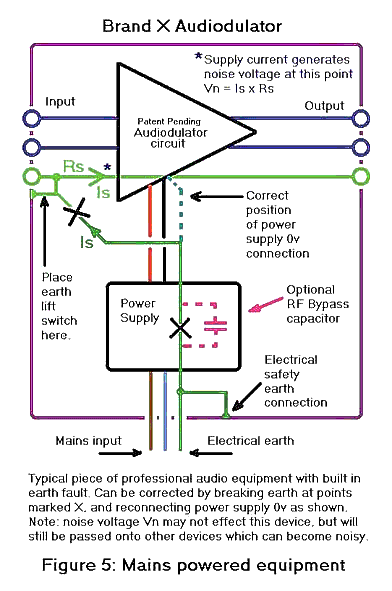
If the device connected by a balanced connection to the mixer, this noise voltage will not be amplified by the mixer input, but if the two earths are connected the noise current will be passed on to the mixer where it can cause a problem somewhere else. This is usually most obvious on the auxiliary busses, hence the litmus test.
If on the other hand the device is connected with an unbalanced circuit, the mixer will not know the noise voltage is spurious and will amplify it along with the desired signal. And it can still cause a problem elsewhere as well.
The best solution is to break the connection between mains and signal earths in the external device. Check to see if the device has a mains earth lift switch and use it. See figures 6 & 7 for tips on how to wire balanced and unbalanced inputs and outputs together without creating earth loops. Don’t cut the supply lead earth wire or use “suicide plugs”, as this is illegal, and dangerous.
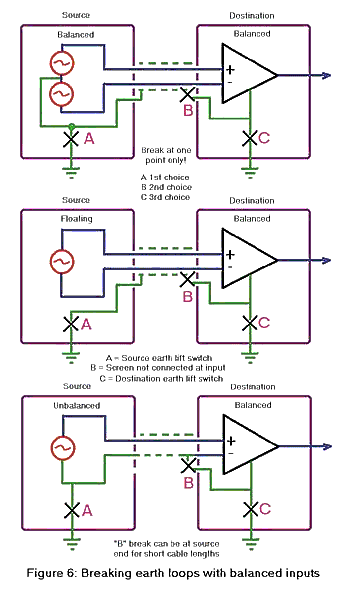
If there isn’t an earth lift and the circuits are balanced or quasi-balanced, you can get by with inserting some XLR adaptors with the pin one (earth) connections removed, to break the connection between devices.
Alternatively if the device is unbalanced, you may get away with lifting the signal earth connection and relying on the earth through the mains, but this is not ideal. The best options are to install a balanced isolating transformer between devices or to get your electronics guru to modify the device so that you can isolate earths correctly as described above.
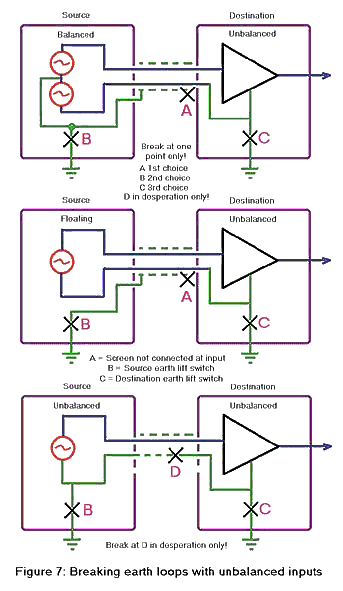
Amplifiers, Crossovers and Other Stuff
Note that the above troubleshooting methods apply equally to connections between all bits of mains power equipment, not just mixer inputs and outputs but also between mains powered peripherals, such as crossovers and amplifiers.
Starting from the loudspeaker, work backwards towards the mixer, plugging in devices and listening for spurious noises in the loudspeakers. With just an amplifier connected to a loudspeaker, ie with no input to the amplifier, you should hear just sshh… noise in each driver. Warning: if you want to keep your hearing intact, do not plug in signal lines whilst you have your head in front of a loudspeaker!
Why Isn’t Earth – Well, Earth?
In Australian power wiring, we have a three-wire system containing an active (hot) wire, a neutral (cold) wire and a safety earth wire. The earth wire is not intended to carry current, but is there purely to shunt electricity from a faulty appliance to ground, thus protecting the hapless creature using said faulty appliance from toasting by electrocution by personally being the shunt to ground.
At the electrical switchboard (fuse box) the earth wire is connected to, you guessed it, the earth, via a metal stake driven into the ground. For reasons of archaic origin, the earth is strapped (bonded) to the neutral wire in switch boxes, which is what ensures the neutral is “cold”. Neutral wires do carry current and therefore, according to Ohm’s Law, will have voltage drop. Thus the neutral voltage at a mains outlet at one point in a building will be different to other points.
Electrical installations for buildings are usually wired according to the MEN (Multiple Earth Neutral) system described in The Australian Standard SAA Wiring Rules. Under this standard, earths may be strapped to neutral in each switchboard, not just where the main power feed comes into the building, hence different earths around a building can and will be at different voltages above ground! If any neutrals are carrying dimmed lighting current, then the earths will have dimmer buzz on them, guaranteed.
Even in a building where the earth is tied to neutral at only one point, there will be some small potential differences on earths at different points induced by capacitive and inductive coupling from the wires carrying voltage and current. One solution is to have a dedicated isolated technical earth, but except in the most extreme of circumstances this really isn’t necessary. Having a rock solid ground reference is not essential. What is essential is an understanding of good earthing and screening techniques, which will solve this interference problem and a lot of others as well.
John Matheson designs electro-acoustic systems for Bassett Acoustics.

